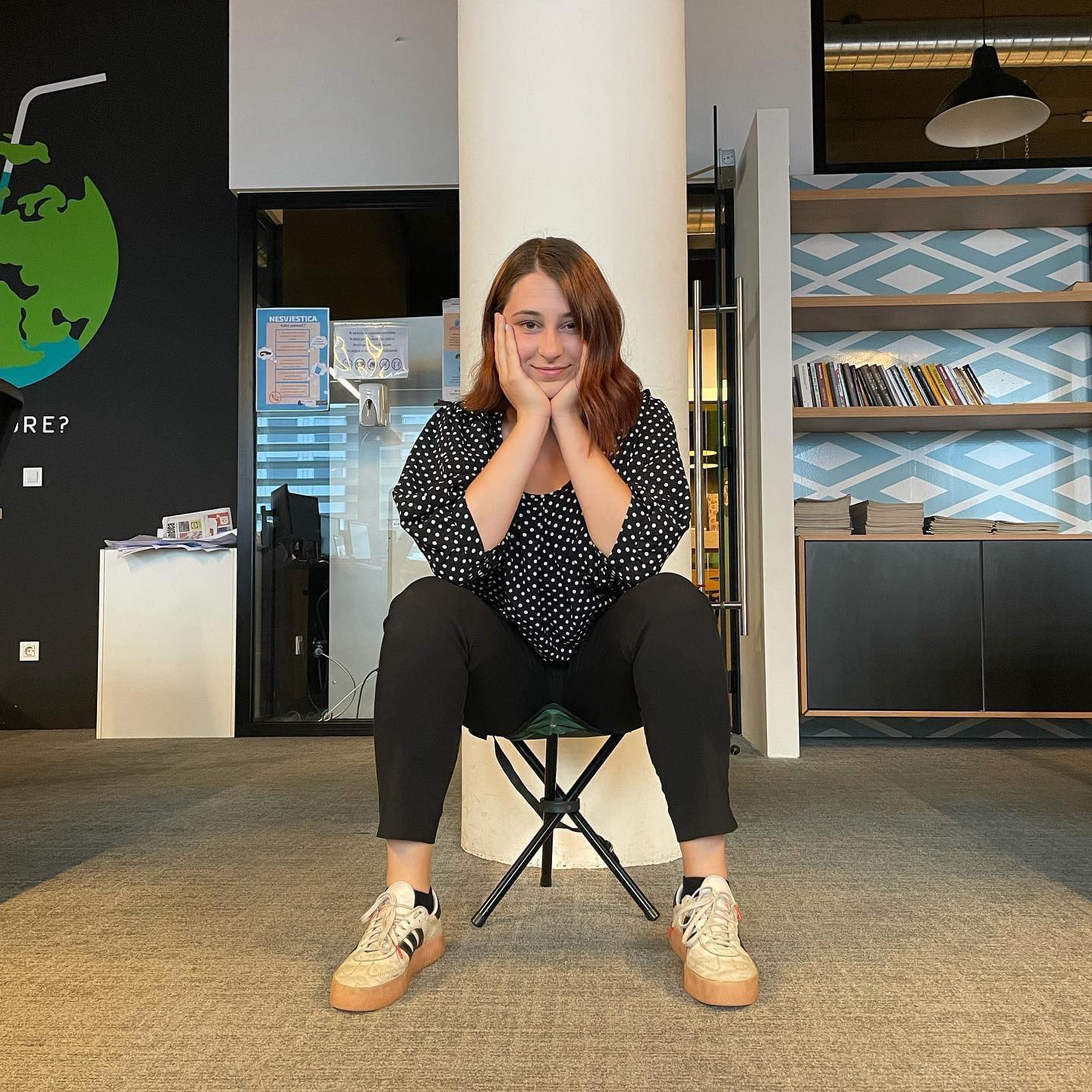Croatia Mulling Increase in Capacity of Krk LNG Terminal
ZAGREB, 26 March 2022 - Croatia is considering the possibility of increasing the capacity of its LNG terminal on the island of Krk from the current 2.6 billion cubic metres of gas to 2.9 billion cubic metres annually, Prime Minister Andrej Plenković said in Brussels on Friday.
He explained that the current infrastructure allows for this increase.
"We believe that we can achieve this increase with the current infrastructure of our LNG ship and all the existing plants there," Plenković said after the end of the two-day summit meeting of the European Union, which discussed Russia's military aggression against Ukraine, energy and energy price hikes.
Plenković reiterated the strategic importance of the Krk LNG terminal for the diversification of gas supply routes, particularly in the current crisis.
Considering the EU-US partnership expressed in the Joint Statement on the Liquefied Natural Gas (LNG) imports from the US, which expect to rise, Plenković said that investments in LNG terminals and the accompanying infrastructure would definitely grow, adding that it remains to be seen how many ships are available.
Ukrainian refugees
Plenković told the press that Croatia had already taken in 10,000 refugees from Ukraine, who fled the Russian invasion of their country.
It is certain that more and more refugees will arrive and that they will stay longer, he said.
Croatia can cover the costs of accommodation of Ukrainian refugees on its own until a joint model for financing is not found at the EU level, the premier said.
HAC Looking for Three Security Guards to Monitor Krk Bridge
February 13, 2022 - HAC (Croatian Highways) is looking for a team of three people to work as security guards and monitor Krk bridge for one year, and plans to pay a total of 850,000 kuna and provide all the necessary amenities.
The job lasts 365 days a year, 24 hours a day, of course, not for the same person, but for several of them, whose mission it is to keep safe the connection between the mainland and Croatia's largest island. Croatian Motorways (HAC) are looking for security guards who will monitor Krk bridge and make sure everything is in order for 12 months, from the houses where tolls were paid until last June to the "other side", and the "gage" to be paid 850 thousand kuna will start in April, reports Večernji List.
As many as 26,280 hours are expected to be done by a team of three people, who will record their arrivals and departures electronically, in order for the employer to ensure that these hours are actually worked, and the company from which the security guards will arrive must provide and real-time digital surveillance of security guards' detours. Why? So that "potential incidents" could be reported at the same time, and a picture of them could arrive. Everything that is done must be submitted to HAC in a report by the 5th of each month, and the Motorways will provide the "guardians" of the bridge less than a kilometer and a half long with an equipped working room with heating, electricity, telephone, toilet, and dressing space”.
''The Krk Bridge is a protected object of national importance, which needs to be safeguarded in order to prevent illegal actions directed towards it'', HAC explains. They also mentioned that "no devices and equipment for technical protection have been installed on the Krk Bridge", so it is "necessary to ensure physical protection, which includes the presence of persons performing protection and guarding activities". Or, in other words, the bridge does not have cameras, so surveillance must be done with the eyes.
''Since HAC does not have its own capacity to perform physical surveillance and protection, it is necessary to provide it from the outside, in compliance with regulations (Law on Private Protection and Ordinance on the conditions and manner of implementation of physical protection)'', they added.
For more, check out our business section.
Krk Island Determined to Become Europe’s First Zero Waste Island
February 8th, 2022 - Krk island is on its way to officially join the list of some five hundred European cities and municipalities that have implemented the international Zero Waste strategy
The management of Ponikve, the main utility company on Krk island, recently met with representatives of Zelena akcija (Green Action), an organisation which is working on implementation of the zero waste strategy in Croatia.
Experts of Zelena akcija analysed the waste management system of Krk island and considered which tasks Krk has yet to fulfill in order to position and brand itself as the first zero waste island in the European Union. They discussed this with Ponikve director Neven Hržić and assistant director Ivan Jurešić, reports Novi list/Mladen Trinajstić.
Waste sorting on Krk already has a 60 percent share in overall waste management, according to Jurešić. The population of the biggest Kvarner island has no intention of stopping there, instead planning to achieve even more ambitious goals.
‘Our cooperation with the organisation [Zelena akcija] is part of the project "Transitioning to zero waste Europe, one community at a time", which, as you might remember, our utility company, or rather the island of Krk, joined last year in July when we signed the decision for Krk to adopt the international zero waste strategy’, said Jurešić.
At the meeting, the parties discussed and agreed upon further steps in the implementation of the zero waste model of maximum reduction of waste, as well as reuse and recycling.
‘The recently held meeting gave us an opportunity to go over and agree on some new, additional measures and activities that we will jointly work on in the coming years, all with the aim of meeting the demanding parameters required for the official inclusion of our island in this prestigious European ecological list’, said Jurešić for Novi list.
Among the agreed goals is a reduction of mixed waste generated by the island’s population - including tourists - from 235kg per person (2019) to 150kg per person annually. They also plan for separate waste collection to reach a 70 percent share in overall waste management.
They have also agreed on certain steps to achieve better use of biodegradable waste, and are planning to establish a so-called Centre for Reuse, a facility where prematurely discarded items will be given a new life.
In order to meet these goals, the Ponikve company will work to improve the method of separate waste collection, charge for collection based on the amount of generated mixed waste, increase home composting, open the mentioned centre for reuse, and introduce numerous models to reduce waste generated on the island, all in the coming years.
Representatives of Zelena akcija consider all the proposed measures feasible, and the agreed goals achievable. They fully expect the local self-government on Krk to meet the set criteria for a zero waste certification.
‘We are pleased with the successful cooperation with the local authorities on Krk island, as they are among the few in our country to have met the goal of separate waste collection in the share of 50 percent by the end of 2020. In cooperation with us they set even more ambitious goals and measures that will help them secure a better quality of life for the island inhabitants, but also put Krk island on the European map of the most successful local communities when it comes to sustainable waste management’, said representatives of Zelena akcija in a statement after the meeting.
How Much for a Cold Drink on Krk Island? Just Give Baba a Kiss
An ancient custom on Krk island involves planting a kiss on a wet rock on the side of the road. Looking into the curious ethnological phenomenon on February 1, 2022
Many holidaymakers have discovered the charms of Baška, a picture-perfect town on Krk island. There’s plenty for this dreamy destination to boast, including a 1800m long pebble beach ideal for those who love to soak up the sun, and adventure trails for visitors who prefer an active vacation.
Visiting Baška wasn’t such a simple feat back in the day, judging by an ethnological phenomenon described by Alan Žic-Teklin of KrkDiscovered. When arriving in Baška for the first time, one was obliged to kiss a wet old woman on the way to town. No, this doesn't sound any more enticing nor any less wrong in Croatian: poljubiti mokru babu.
(Baba stands for old woman, crone or grandma, depending on the context. In this scenario, it falls somewhere between the first two, but we’ll go with the more respectful option to avoid upsetting any ancient spirits. You never know.)
Thankfully, this particular baba was simply a common nickname for stone monoliths scattered over the island. Always located in damp spots near water springs - hence the wet part of the name - the rocks were referred to as babe and the custom dictated to give them a kiss when passing by.
Where did this come from? Legend has it that St Jerome (4th century AD) was visiting the bishop of Krk and got thirsty while traversing the island. He hit a rock with his staff, causing water to spring from stone.
Since one would have to lean close to the rock and press their lips against the surface to get a drink of water, this would have resembled kissing the rock, and so the saying was born.
Legends aside, the local custom of kissing the stone baba has long been a subject of interest of historians and ethnologists. Jelka Vince-Pallua, PhD proposed a theory that the custom originates from ancient fertility cults that were practised before the monoliths, while ethnologist Nikola Bonifačić-Rožin considers that the ‘old women’ stem from an ancient superstition that the rocks will prevent the floods from washing away precious fertile soil.
The best known baba on Krk island used to be located on the side of the road at the locality Žanac near Baška. The ancient rock isn’t there anymore and has been replaced with another one, but to keep up with tradition a pipe has been installed on the location, allowing passersby to get a drink of cold water.
And the new rock that stands in place of the old monolith? It’s part of the Baška Glagolitic Alphabet Trail, a series of 35 stone sculptures displayed on a trail meandering through the Baška Valley, each bearing a different letter of the Glagolitic alphabet.
Glagolitic letters Ž and E are carved into this particular stone, standing for Žanac est! Loosely translated, it means ‘Here is the Žanac spring!’ pointing to the wealth of water resources in the area. As early as the Stone age, people inhabiting Krk island first settled in Baška Valley precisely for its many water springs.
Even though it’s not the original baba, the sculpture allows travellers in passing to respect the ancient custom and give baba a peck on the cheek if they so decide. Don’t find the prospect that enticing? You can simply mark the sculpture on your Glagolitic Trail guide - every monument has a small plaque with raised letters you can copy into the blank pages in the guide. (Copy them all as proof you visited all the locations on the trail, and you get a little gift.)
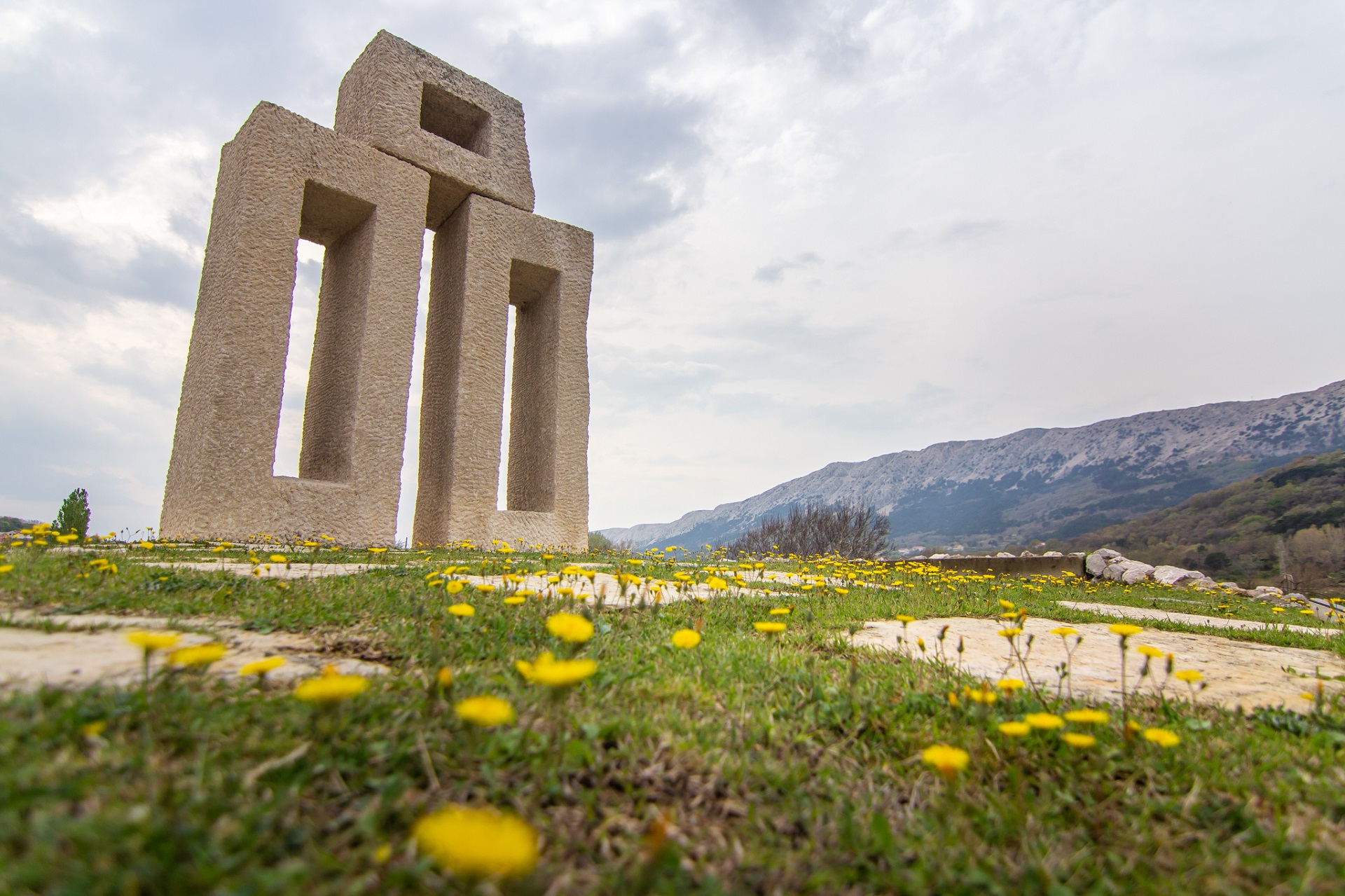
The letter L, sculpture by Ljubo de Karina / visitbaska.hr
The Glagolitic Trail project was devised by the Sinjali Association for culture, tradition and ecology from Krk. Each sculpture was sponsored by a different town; four were created by the renowned Croatian sculptor Ljubo de Karina, the rest were made by fifteen art academy students from Croatia, Slovenia, Austria and the Czech Republic.
The trail was created to highlight the rich cultural heritage of Krk island and to serve as a reminder of the importance of the Glagolitic alphabet in Croatian history. The Baška tablet in particular - perhaps the most distinguished attraction in Baška, at least where Croatian culture and history are considered.
Discovered in the church of St Lucy in Jurandvor and dating to 1100, the limestone tablet is a legal document bearing an inscription where the Croatian name (hrvatski) is mentioned in writing for the first time in history, in Glagolitic script.
You can learn more about the Baška Glagolitic Trail in this pdf guide, and follow Krk Discovered on Facebook.
Free Tourist Tour of Krk Old Town to Be Held on January 15th
January 13, 2022 - As part of an initiative of the Association of Croatian Tourist Guides, on the occasion of the 30th anniversary of the international recognition of the Republic of Croatia, the Kvarner Tourist Guides Association traditionally organizes free organized tours, and this year will be around Krk Old Town.
All interested citizens and visitors can join the tour of the Krk Old Town this Saturday, January 15 at noon, which includes a visit to the Frankopan Castle and the Interpretation Center for the History of Maritime Heritage of the Island of Krk; the place of departure is on the waterfront in front of the sundial, reports Turističke Priče.
The Association of Croatian Tourist Guides organizes the project "Get to know your country", through free guided tours for citizens in Croatian cities, on the occasion of marking the Day of International Recognition of Croatia.
In addition to organizing free tours in cities where ZDTVH member associations operate, free guided tours were organized in smaller cities belonging to the counties where ZDTVH member associations operate, as well as in areas where tourist guide associations have not been established. Prior to the pandemic, this extremely successful project took place at the same time in 60 cities across Croatia.
Given the positive reactions of a large number of citizens and the media in recent years, the project is repeated this year and points to the importance of tourism professionals for Croatia's international reputation, as well as the importance of national identity and cultural heritage.
The tour of the city of Krk will be held regardless of the weather conditions and with strict adherence to epidemiological measures.
Announcements are required to the email address: This email address is being protected from spambots. You need JavaScript enabled to view it.. It is necessary to state the number of registered persons and the location for which you are applying. All additional information can be obtained at 0958611913.
You can find more information at the official website of the Tourist Board of the Town of Krk.
For more, check out our dedicated travel section.
Krk Outdoor Destination: Rebranding Island for Active Tourism
January 11, 2022 - Krk Outdoor - a rebranding of the island launched this year to cater to active tourism.
With the joint funds of all local governments and Krk Island tourist boards, with the support of the Ministry of Tourism and Sports and coordinated tourist board funds, a new "Krk Island outdoor brand and communication strategy" was created, reports Novi List.
Director of the Krk Tourist Board, Majda Šale, said that this is a new step forward in promoting the trump card of the island's tourist offer. The strategy was created in cooperation with the Studio Conex agency from Samobor. It was formally adopted after a recent presentation to the directors of all local tourist board offices and the Krk Island Tourist Board members.
"In addition to representatives of local self-government units and tourist boards, a significant number of external associates and partners were involved, especially those with whom the Krk Island Tourist Board cooperates in the segment of organizing and implementing outdoor projects and programs - an offer that is the focus of our new strategic document," said Šale, emphasizing that the mentioned plan is based on the concept of sustainable and balanced development of tourism on Krk, among other things through its branding and development as an outdoor destination.
This type of offer has the power to attract many new visitors in the pre and post-season. The mentioned document analyzes the current state of Krk's outdoor activities, following which strategic guidelines for building the "Krk outdoor" brand were processed and determined. Its main goal is to create a market identity and recognition of this offer. The inputs to which answers are given are diverse tourist products and the development of new products and programs harmonized with the interests and needs of modern guests, i.e., with recent trends in tourism, on an island that is easily accessible, highly developed, and environmentally sustainable, continued Šale.
The newly presented brand and the communication strategy that will promote Krk outdoor in the future will include a series of activities that will take place in phases, including education, creating a database of island outdoors, and organizing internal events. The strategy also defines ways of cooperating with local media, building websites and producing promotional materials, managing social networks, advertising, appearances at fairs, and other activities that we believe will ultimately lead to a unique island image, greater recognition of Krk as an outdoor destination and finally, to its better positioning in the emitting markets, says the head of the island's tourist board.
With the new strategic and planning steps, the island's tourism workers have kicked off the rebranded tourist offer by designing a new promotional logo.
"After fifteen years using the current Krk Tourist Board logo, we started redesigning it last year, necessary to achieve better visual recognition and adapt to new market demands. We are convinced that the new logo is a modern logo that will achieve even higher recognition of Krk Island. The newly created "book of standards" will provide a more professional approach to producing all our future promotional materials. The authorship of the new logo is designer Valter Stojšić. It consists of three colors - green, yellow, and blue, the colors of the island that symbolize nature, the color of the sun and the "golden island," and the sea.
The logo is stylized in the contours of Krk, with an inscription and typography on several language mutations according to the markets to which we will target it. The new logo will be placed on all new promotional materials, used in the official correspondence of the Krk Tourist Board, at fairs, and in all future advertising, concluded Šale, adding that its official use will begin in 2022.
For more, check out our dedicated travel section.
Camino Krk Recognized at International Sustainable Tourism Awards
December 21, 2021 - As part of this year's International Award for Sustainable Tourism (Skål International Sustainable Tourism Awards), the project Camino Krk was awarded the International Prize for Sustainable Tourism.
The Camino Krk project, in competition with ten other initiatives from different parts of the world, in the category of Rural / Rural Areas and Biodiversity (Countryside and Biodiversity), as one of the nine set categories, is positioned in third place, reports HrTurizam.hr.
This year, the evaluation of projects received in the public call was conducted by three independent judges, giving them grades that are then added up, so the initiative with the highest score wins in its category. Although Camino Krk did not win, it was highly rated, which is a great success, according to the Tourist Board of the City of Krk, adding that they will be reminded of the certificate received in recognition of commitment to sustainable practices and implementation of environmentally friendly business model.
"First of all, I must point out that all island tourist boards have made a significant contribution to the development of the Camino Krk project in terms of a new and innovative tourist product. In uncertain pandemic circumstances, after we defined the project in cooperation with the Brotherhood of St. Jacob, we decided to invest significantly in its further development. Therefore, this year Camino Krk was the focus of all tourist boards, which means that significant funds were invested in marking the entire route, involving stakeholders, creating promotional materials, and strong digital promotion," said Ivana Kovačić, director of the Tourist Board of Krk.
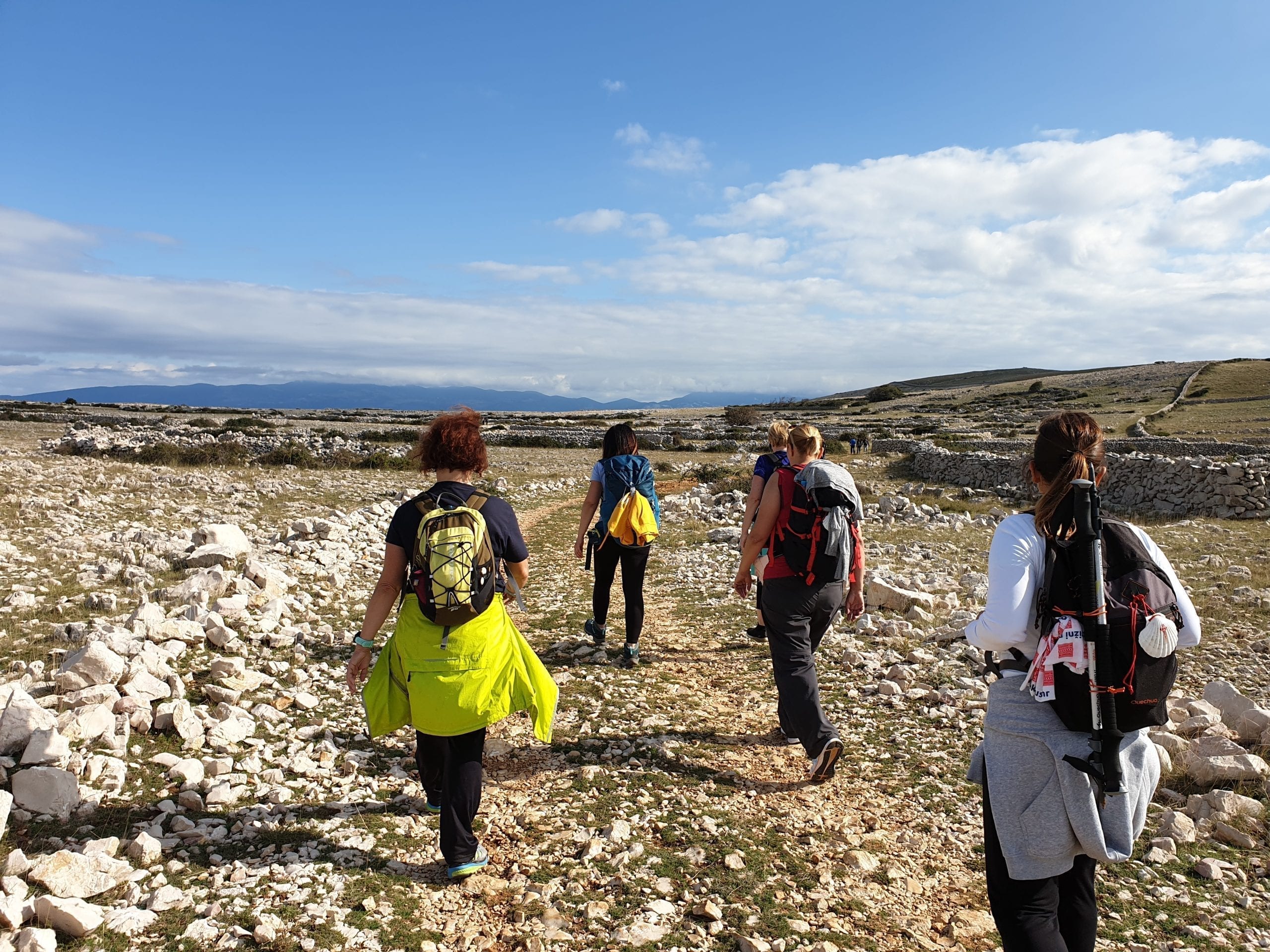
Photo: www.experiencekrk.com
The explanation of the evaluation states, among other things, that the activities related to Camino Krk have little impact on the environment and that the project itself encourages the dispersion of tourists to rural areas and the interior of the island, thus spreading economic benefits and moving away from established sun-sea concepts.
If the activities of tourists, as is the case with this project, do not adversely affect the environment, as a next step and a kind of upgrade, it is proposed that all its stakeholders, at all levels, accept the principles of sustainability in both environmental and economic terms.
"This year there was a significant interest of our guests for active holidays, staying in nature and getting to know the natural, cultural and historical heritage, and Camino Krk met their expectations by adding warmth and spiritual component to this potential-filled tourist story. In further efforts, we will certainly pay significant attention to the comments and suggestions of tourism experts received based on the application to the public call of Skål International and try to further strengthen the cooperation of all project partners," adds Kovačić.
Recall, the Camino de Santiago or the Way of St. Jacob's pilgrimage route is about 800 kilometers long and is walked by more than three hundred thousand pilgrims a year. In 1987, the Council of Europe awarded it the title of Main Street of Europe, and in 1993, UNESCO included the Spanish and French parts of the route to the Galician capital, Santiago de Compostela, on the World Heritage List. Road network of St. Jacob leading to one of the world's three leading pilgrimage centers that inherit the relics of St. James the Apostle is spread all over Europe and is most often marked with a stylized shell - James' cap, as the (primary) saint's attribute.
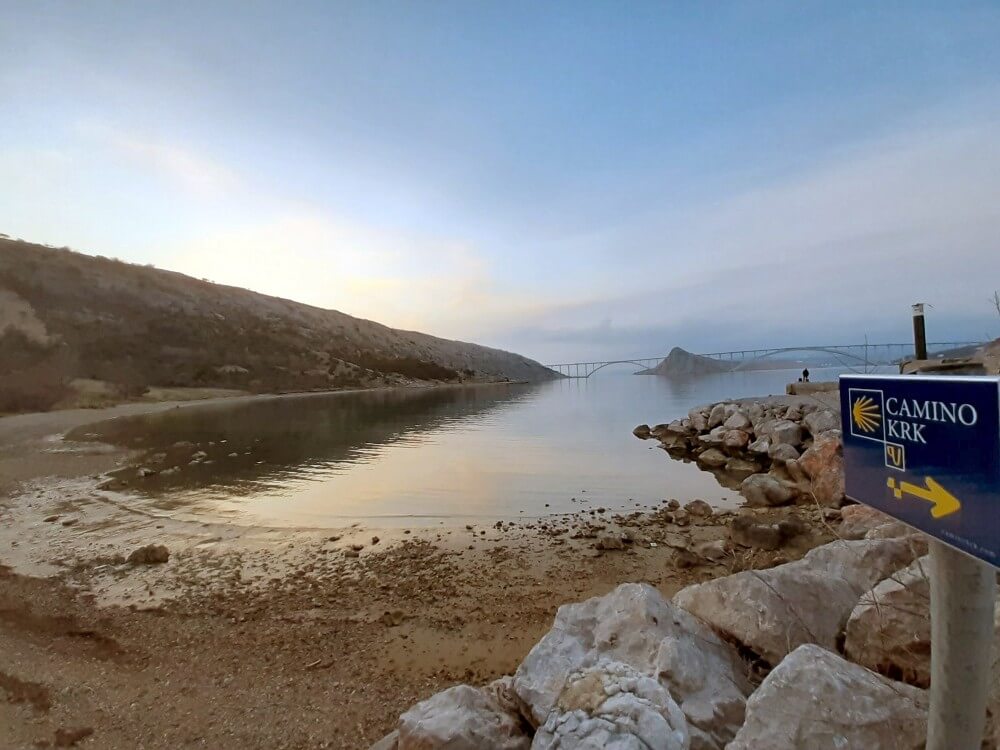
Photo: www.experiencekrk.com
The celebration of the Krk part of the Croatian Camino route took place between 2019 and 2021. Camino Krk is defined as an (all) island circular route, with a total length of more than 150 kilometers, which follows the infrastructure of existing hiking trails. Its starting point is in the island center - the town of Krk, ie the Krk Cathedral, and the final one in the village of Kornić, in the parish church dedicated to the Apostle St. James.
The tour of the Krk route is divided into seven pilgrimage chapters, more precisely seven days needed to truly experience the island's historical, cultural, and especially sacred heritage immersed in impressive natural environments and unique urban units. For easier navigation on the island of Camino, Krk is marked with recognizable, blue-yellow signs, and in addition to signalization, there is also an interactive digital map that allows tracking the route using a smartphone.
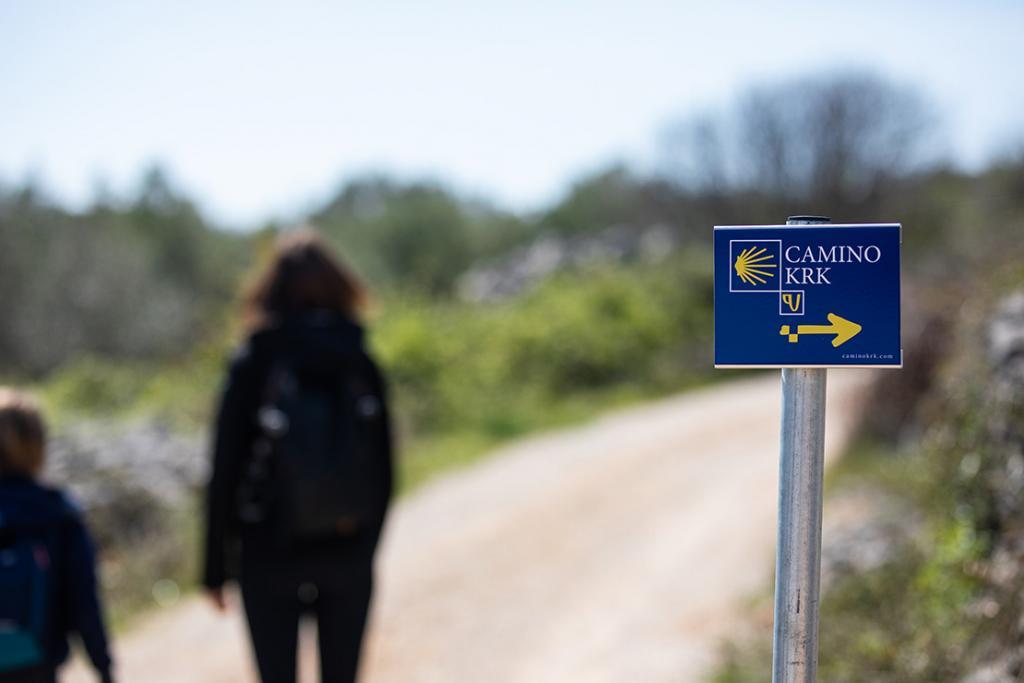
Photo: www.otok-krk.org
This project, since its launch, has attracted significant interest from both domestic and foreign pilgrims, walkers, and other recreationists, mostly Slovenes, Italians, and Austrians, which has intensified in periods affected by strict epidemiological measures.
The Skål International Sustainable Tourism Awards are presented each year to companies, institutions, agencies, and other private and public associations related to tourism.
It is a recognition that, evaluating the effects of sustainable and responsible tourism, contributes to the global visibility of applicants and registered initiatives. By entering the competition, the applicant presents its products and services to globally known experts in the tourism industry, while ensuring significant media visibility.
Skål International unites all branches of the tourism industry and operates through more than 340 clubs with almost 14,000 members in more than 100 countries, while its mission is to promote the development of responsible, sustainable, and universally accessible tourism.
For more, make sure to check out our dedicated travel section.
New Krk Island Tourist Map Published in Preparation for 2022 Season
October the 7th, 2021 - The beautiful island of Krk is and always has been very popular with tourists from the rest of Croatia and from all over the world alike. Given the fact that this year's summer season went remarkably well, preparations have begun for 2022 and a brand new Krk island tourist map has been published.
As Morski writes, the new Krk island tourist map has been created and published with the intention of intensifying promotional content, in the context of preparations for the next tourist season, and the Tourist Board of the island of Krk has focused part of its activities precisely in this direction.
In addition to the redesign of the Krk information brochure, which includes all relevant information for the island, a new Krk island tourist map was published back in early September, containing all of the most important and clearly structured data on various island destinations, in a shortened, easy to follow version.
It is a B1 format map (700 x 1000 mm) with all of its content arranged on two sides. The first side contains a map of the island with marked cultural and historical monuments, information centres, general information and advertisements related to previously published cycling and walking maps, while the second includes data on destinations: the City of Krk and the municipalities of Omisalj, Malinska-Dubasnica, Punat, Baska, Vrbnik and Dobrinj.
Each of these destinations is presented with full descriptions, recommendations, gastronomic specifics and outdoor activities, and events, cultural and historical sights and other attractions are singled out in separate units. The texts included in the map were published in Croatian, English, German and Italian, while its design was entrusted to Valter Stojsic.
In the coming period, this new Krk island tourism map will be available at fairs attended by the Tourist Board of the island of Krk, and can currently be downloaded at the tourist information centres of all island destinations, including the Krk Tourist Information Centre, located on Ulica Josip Juraj Strossmayer 9.
With the intention of adapting to the growing trends of digitalisation, and with the aim of introducing environmentally friendly solutions, the preparation of this Krk island tourist map in the digital version is currently underway, which will lead to the creation of a corresponding QR code.
For more, make sure to check out our dedicated travel section.
Ignored by Family, Dana Adamcova US Friends Start GoFundMe Campaign
September 25, 2021 - With no memory, money or family willing to help, friends in California have set up a Dana Adamcova GoFundMe campaign to help the 'mystery woman on Krk.'
It is certainly one of the most curious stories we have covered in the six years of Total Croatia News, and few stories in Croatia have attracted such global attention.
But now that the identity of the mystery woman of Krk has been solved, some 10 days after she was rescued bloody, dehydrated and disorientated from a remote part of the island of Krk - with no memory of who she was or how she got there - most of the world has moved on from the story, with curiousity satisfied.
The fact remains, however, that there is a 57-year-old woman from Slovakia in a hospital in Rijeka, with no memory of who she is, and with no money to her name. Croatian media managed to speak to her family who have said that they will not come for her. According to an interview on TCN yesterday with the journalist (Laura Siprak from 24Sata) who spoke to one of her sisters, they were not on good terms, and they last spoke over 3 months ago, when Dana said she was moving to Spain.
But there are friends from her past life who do care, and who have been very helpful in both identifying Dana, and providing photos and information about her.
Nina Smidt in Los Angeles is one such person, and she contacted TCN a few days ago with lots of information which indicated that Dana was the missing woman. Coupled with other information we received in the TCN inbox, it allowed us to identify her with certainty 10 days after she was rescued. Several hours later, the Croatian police confirmed that the identity was that of a 57-year-old woman from Slovakia. They had received the same information but from a different source.
Nina has been fielding lots of calls from journalists, as well as many people who want to help. Hearing that there is little to no help from Dana's family, she has decided to set up a GoFundMe campaign to raise some money for Dana to get herself back on her feet. Nina and her friend Tyler Madsen knew Daniela back in 2015 in Los Angeles, where they worked together, with Tyler helping Dana with accommodation as she was going through a tough time. Later in 2015, they took Dana to the airport to start a new life in Ireland. And that was the last she heard of her until she saw her photo as the mystery woman in Croatia with no memory.
Nina and Tyler explained to TCN why they had decided to set up a GoFundMe campaign for Dana:

"We felt a moral responsibility to support Daniela during this difficult time and to provide a call to action for the next part of this mission, which is getting Daniella the financial assistance she so desperately needs. She is facing unfathomable challenges ahead and is in need of a helping hand.
"The concern from compassionate individuals across the globe, the incredible efforts of the media to tell her story, and the understanding that after the rescue comes the recovery is what inspired us to mobilize this fundraiser."
The campaign has just gone live, and you can read the whole story - and/or donate - on this link. The target set is US$15,000.
You can follow TCN updates to this story here.
Dana Adamcova: New Details, Chat with Mystery Croatia Woman Family
September 24, 2021 - It is 2 days since the 'mystery woman in Croatia', Dana Adamcova was finally identified, some 10 days after being rescued from a remote part of Krk with no memory of who or where she was. Many details remain unclear, but a lot more information is provided in this interview with Laura Siprak of 24Sata, who has been following the case closely.
It is a story which attracted global attention for several days. But while the identity of the mystery lady on Krk has now been established - 57-year-old Dana Adamcova (full name Daniela) from Slovakia - there is still much which is unknown in the events leading up to her being in such a position.
While TCN was the first to reveal her name after various contacts from friends and well-wishers in the United States, Croatian journalists have been working more local angles to put together various pieces of the jigsaw, and yesterday we published the findings of an RTL Direkt television report.
Another portal which has been very active - I did not realise quite how active until I requested this interview below - is 24Sata.hr. Journalist Laura Siprak and I have been exchanging information on the story, and I thought that rather than just report on what she and her colleagues had found and written about, it might be better to interview Laura in her own words. While I have been reporting on this sitting on my sofa at home, Laura and her colleagues have been all over Croatia in search of clues, as well as speaking to members of Dana Adamcova's family in Slovakia.
Laura kindly agreed to tell us more, and to allow us the use of these photos taken from relevant parts of the story.
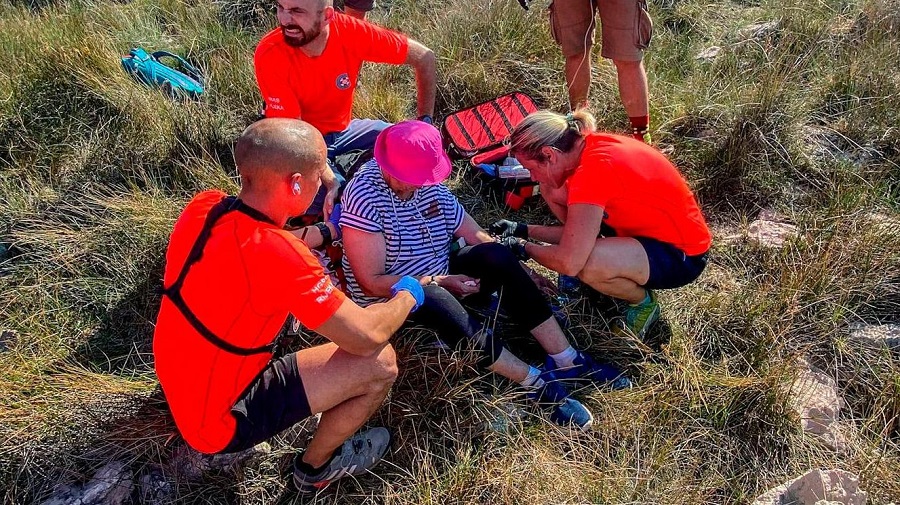
(Dana Adamcova was rescued by the Rijeka branch of the Croatian Mountain Rescue Service. More on that story here.)
You have reported on the case in considerable detail, and little of your findings has appeared in the international media so far. Let's start with retracing Dana's steps before she got to Krk. What can you tell us about her arrival to Croatia and her time before she went to Krk?
We have been on this story from the minute that authorities asked the media for help. My colleagues Meri Tomljenović, Hajrudin Merdanović and Tina Jokić gathered the first information. Soon, her friends and acquaintances contacted us. We found out that she came to Croatia with a group of people via Regiojet train at the beginning of September. At some point, she left them and turned off her mobile phone.
A couple from Czechia spoke to her at a bus stop in Donja Vala in Drvenik (between Split and Dubrovnik) on 9 of September. We know she was there the day before because she told them that the bus didn't come. Before that she was on Hvar and Korčula. She told the couple that she wanted to go to Lika and was happy that the bus from Donja Vala drove to the place she wanted. Tina Jokić went to Drvenik and Donja Vala to search for clues there. The next sighting was in Rijeka. There she took the bus on the 11th (it's presumed) to go to Krk.
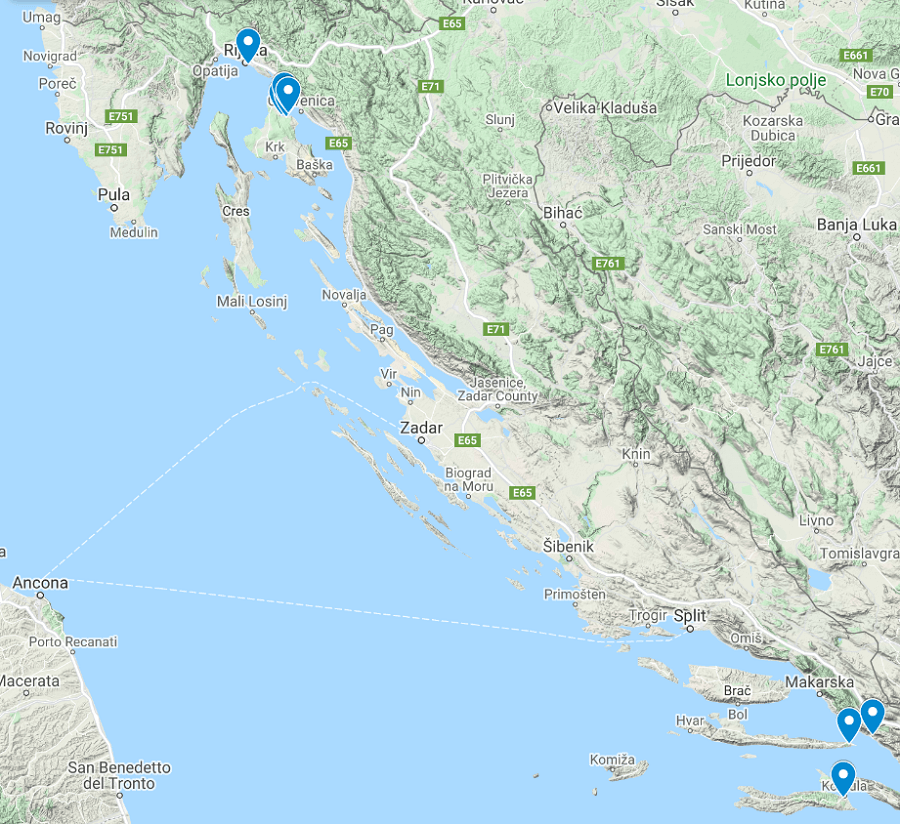
(Dana Adamcova was reportedly in the south of Croatia, on the Dalmatian islands of Hvar and Korcula, before taking the bus from Drvenik to Rijeka in the north, and then on to Krk)
2. You have also managed to speak to members of her family in Slovakia. Tell us more about that.
This is the part that intrigued us the most. She has two sisters, one of them is in Trenčin, the same city Dana is from. She also has nephews and a niece. Her sister told us curtly that she doesn't want to do anything with her. Her niece explained that they are not on speaking terms. They spoke last in July, and Dana told her sister she was going to Spain to work as a cleaner or maid. They didn't know she was in Croatia. The Slovakian Embassy were told by the family that they don't want anything to do with this whole case. We know she has an ex-husband in the USA and presumably one in Ireland (she told a friend she married in 2018 and had some health problems). But nobody was looking for her. The missing person report was filed by an old friend from school.
3. What is the latest update you have on Dana's condition, and what will happen next, do you think?
The last thing we found out is that she is still in hospital in Rijeka. She is stable but still suffers from memory loss. They are trying to determine what led to memory loss and how they can fix that. In my opinion, there are two possible solutions. Either she will stay in Croatia until she is well enough to go back to Slovakia and live on her own, or they will diagnose her and then she will be sent to Slovakia for treatment.
4. Congratulations on all the details you have managed to discover so far. For such a global story, there was a lack of information for such a long time. If not a secret, can you tell us a little about the efforts of you and your team to gather all the information?
Thank you. We worked really hard on this. It's not really a secret, it's just a little bit of detective work, field work, luck and a lot of experience that some of my colleagues have.
Meri Tomljenović first went to the island of Krk where she was found and gathered the first information. Hajrudin Merdanović was in constant contact with the authorities and he investigated that alley. He has great experience in finding identities. He actually won the prize for the story of the year with the story about the Rainman who didn't know who he was for 36 years. Kristina Uremović, Nenad Nevešćanin and I were vigorously searching social and foreign media, Google maps, train and bus timetables. Anamarija Burazer first spoke to the couple who saved Dana.
And then, one evening, Neno sent me some posts with the photos of Dana A. I compared the photos and that was her. We found out who she is! We didn't publish it immediately because we were afraid of what if that wasn't her. We already found one woman in Zagreb that looks like her and that was a dead end. But Dana's school friend confirmed that that was her and at 8:50 in the morning, on wednesday, we published the article 'This could be my friend from school'. We were very cautious with everything. Also, I contacted Miriam Kelcic who really helped in discovering Dana's identity and her path.
Next morning, Kristina went to speak with Miriam, Romana Šimek and I went to Rijeka. There we were greeted by photographer Nel Pavletić. The first thing that came to my mind was: how did she get to Rijeka. We went to the bus stop and found out that she came there on the 11th and then she sat on another bus that took her to Krk.
So we went to Čižići on Krk, where she was found. The next thing on my mind was 'She had to buy water somewhere'. We spent two hours talking to everybody in Čižići. Then I thought 'If she doesn't have her phone, she has to ask somebody for directions. Where is the nearest tourist info?' It's in Klimno.
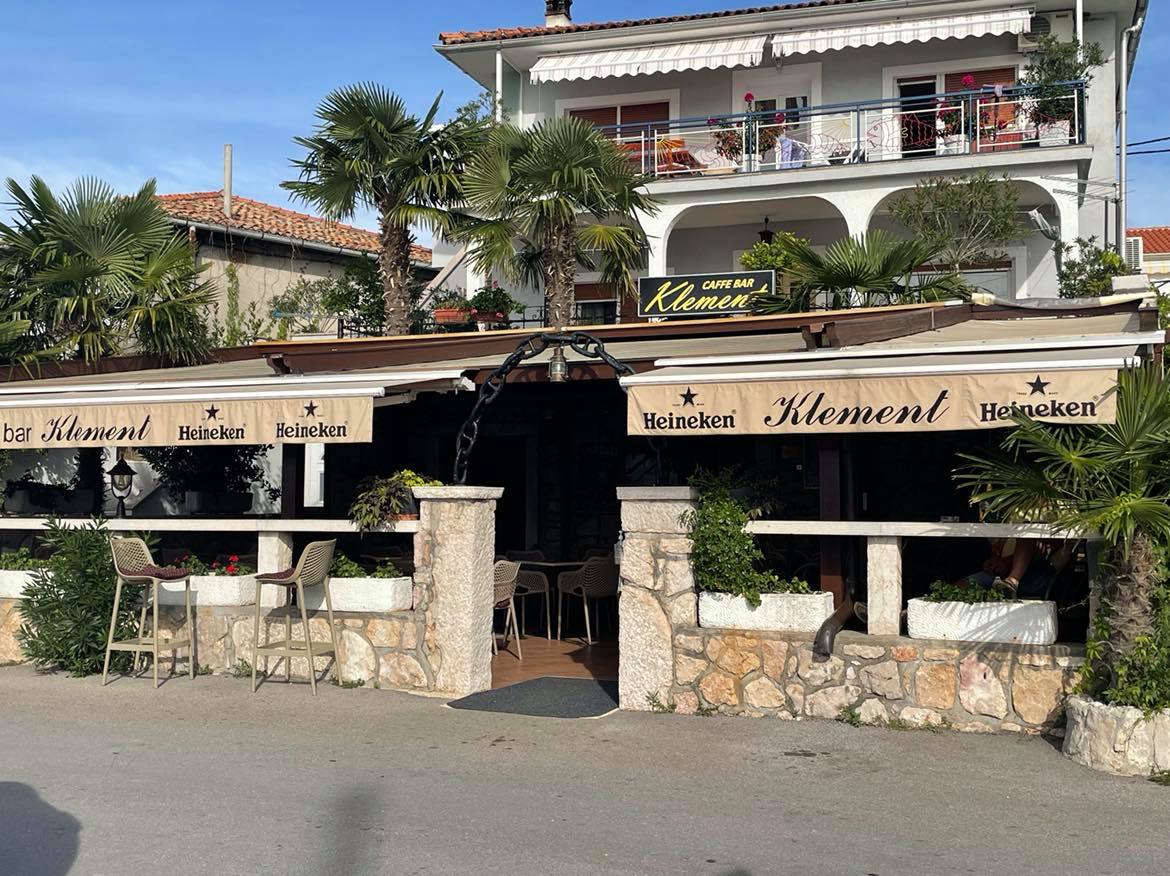
We got there but the office was closed. Next to the office is caffe bar Klement. I went in there and asked the waiter, Stiv if he had seen Dana. He told me 'I drove her to the fisherman's house where she was found'.
I couldn't believe it! At 16:16 we did a live interview with him. Next stop was the fisherman's house where they left her. There was nobody there but the terrain was really bad. A lot of rocks, snakes and some cows. The house was locked but somebody took good care of it. So we went back to Čižići, sat at the first fish restaurant and asked the waiter if he knew the president of the Fishermens club.
We were in luck - it was the same guy who owns the restaurant. He called his friends who were there when Dana came. One of them, Mladen, told us that she asked them how far it was to the nearest big city and that they warned her about the terrain. She still went by foot on those rocks. While we were doing that, Nenad called the tourist companies. And that's the whole story. A lot of teamwork and thinking outside the box. I must confess, I watch a lot of crime shows, so I turned into a little detective as soon as we came to Rijeka.
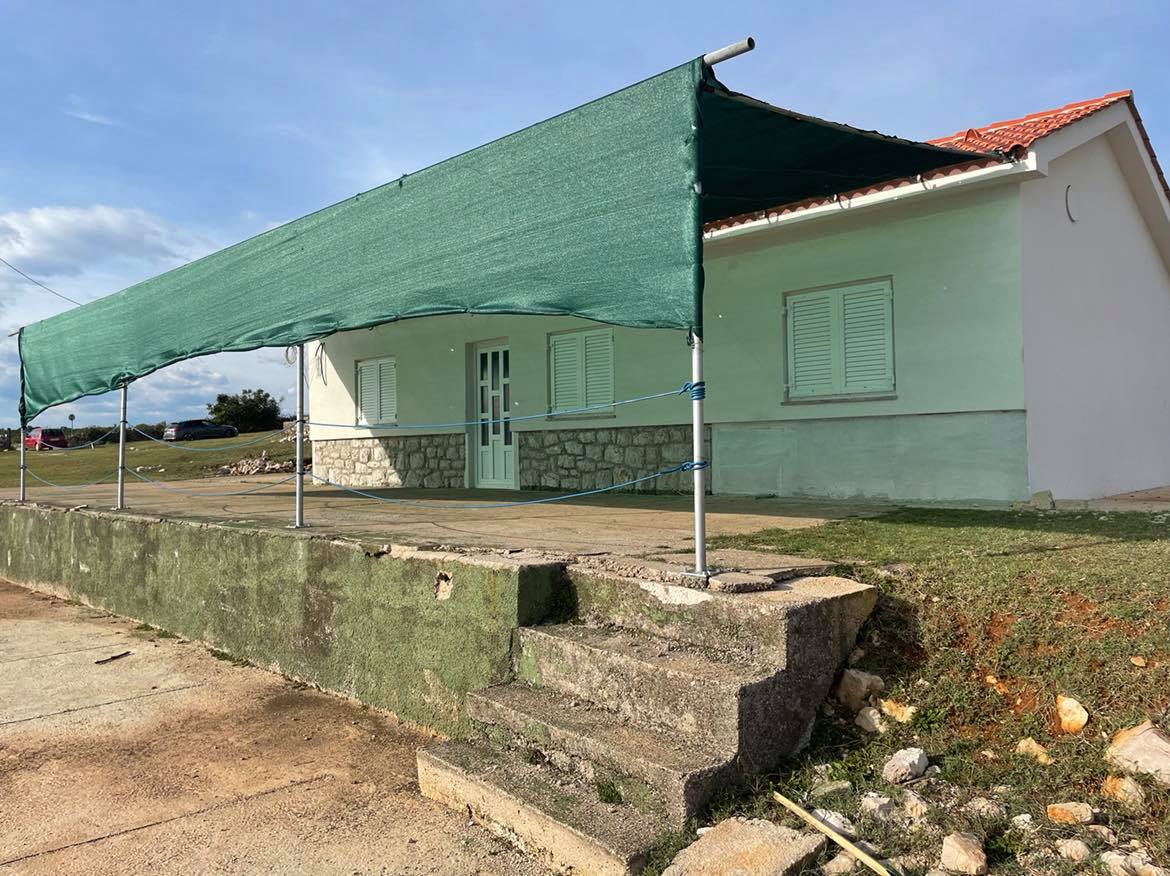
5. What was your biggest breakthough with the story?
Finding her name and the moment we found Stiv. I almost hugged him since we didn't know much until that point.
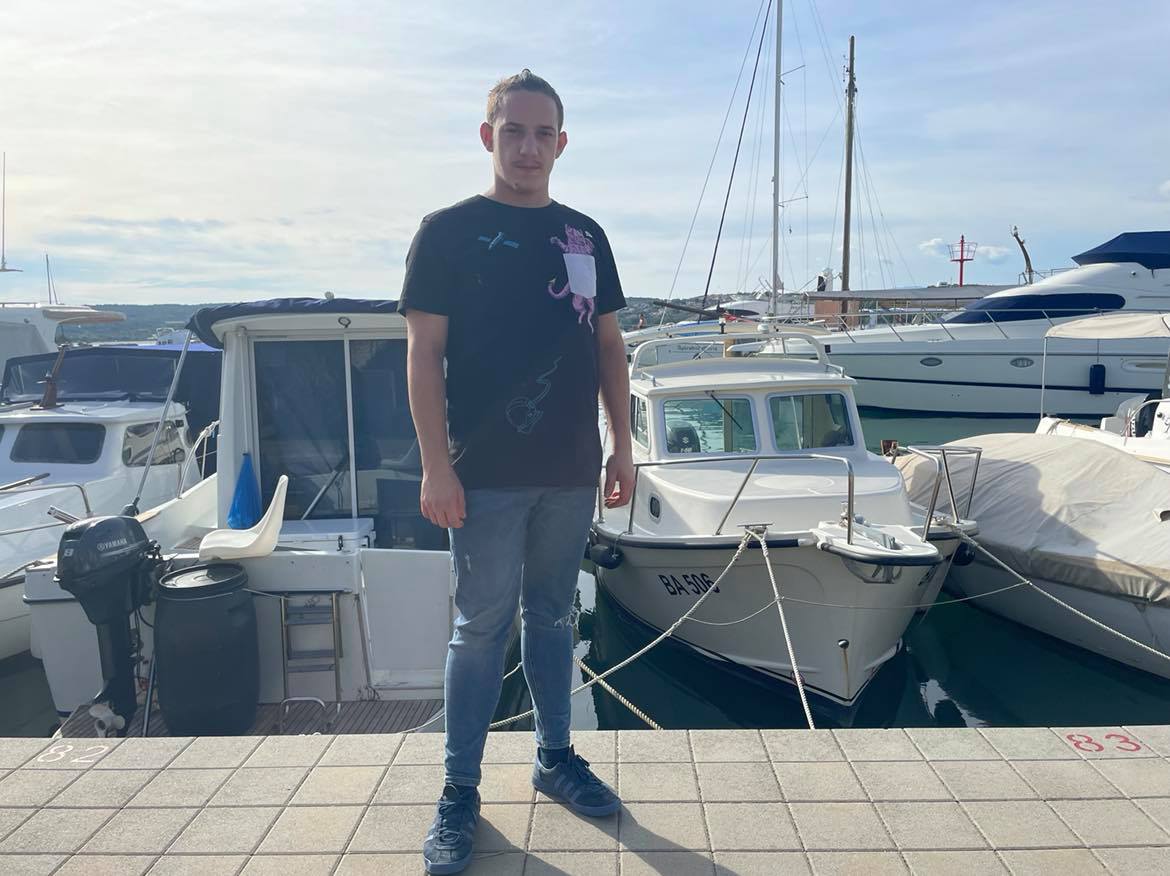
6. What, for you, are the great unanswered questions in this case?
I think there are four key questions. First, a witness told us she had another bag and that her phone was working in Klimno. Where is that another bag and where is the phone? Second, she told Stiv that she was from England and that there are some friends waiting for her at the fisherman's house. That was a lie. Why did she lie? Third, how did she lose her memory? Fourth, where was she between Donja Vala near Drvenik, and Krk?
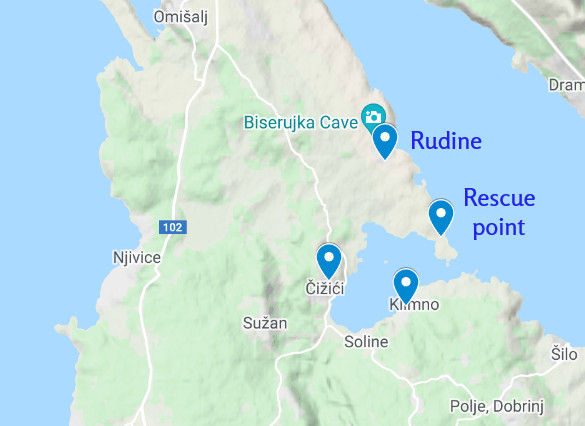
A great team effort by the 24Sata team. Laura, pictured below, concluded the interview by saying:
I think we did our job helping the police and Dana herself with this. The media once again showed that we have the power to do great things when we just do our job.
Dana Adamcova is currently in a stable condition in hospital in Rijeka:
‘The patient is still with us in hospital. I can say that it is medically stable and that in cooperation with other competent institutions to work on further legal proceedings in order to achieve the best in the interest of the patient - her return to her home country. As for her health condition, the patient is in good condition and ready for discharge, 'said the director of the Rijeka KBC, Alen Ružić., for RTL Danas.
If you have more relevant information on this story, please contact us on This email address is being protected from spambots. You need JavaScript enabled to view it.
You can follow Laura Siprak's articles for 24Sata here.
